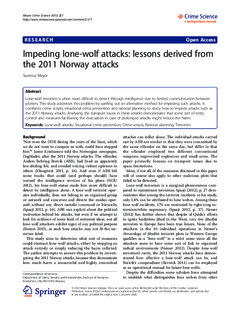| dc.contributor.author | Meyer, Sunniva Frislid | |
| dc.coverage.spatial | Norway | nb_NO |
| dc.date.accessioned | 2019-07-05T07:02:15Z | |
| dc.date.available | 2019-07-05T07:02:15Z | |
| dc.date.created | 2018-01-04T16:06:08Z | |
| dc.date.issued | 2013-12-01 | |
| dc.identifier.citation | Crime Science. 2013, 2 (7), . | nb_NO |
| dc.identifier.issn | 2193-7680 | |
| dc.identifier.uri | http://hdl.handle.net/11250/2603493 | |
| dc.description.abstract | Lone-wolf terrorism is often more difficult to detect through intelligence due to limited communication between plotters. This study addresses this problem by spelling out an alternative method for impeding such attacks. It combines crime scripts, situational crime prevention and rational planning to study how to impede attacks such as the 2011 Norway attacks. Analyzing the transport issues in these attacks demonstrates that some sort of entry control and measures facilitating the evacuation in case of prolonged attacks might reduce the harm. | nb_NO |
| dc.language.iso | eng | nb_NO |
| dc.publisher | Springer Nature | nb_NO |
| dc.rights | Navngivelse 4.0 Internasjonal | * |
| dc.rights.uri | http://creativecommons.org/licenses/by/4.0/deed.no | * |
| dc.title | Impeding lone-wolf attacks: lessons derived from the 2011 Norway attacks | nb_NO |
| dc.type | Journal article | nb_NO |
| dc.type | Peer reviewed | nb_NO |
| dc.rights.holder | © 2013 Meyer; licensee Springer. | nb_NO |
| dc.description.version | publishedVersion | nb_NO |
| cristin.unitcode | 7482,2,2,0 | |
| cristin.unitname | Sikkerhet og atferd | |
| cristin.ispublished | true | |
| cristin.fulltext | original | |
| cristin.qualitycode | 1 | |
| dc.identifier.doi | 10.1186/2193-7680-2-7 | |
| dc.identifier.cristin | 1536143 | |
| dc.source.journal | Crime Science | nb_NO |
| dc.source.volume | 2 | nb_NO |
| dc.source.issue | 7 | nb_NO |
| dc.source.pagenumber | 13 | nb_NO |

